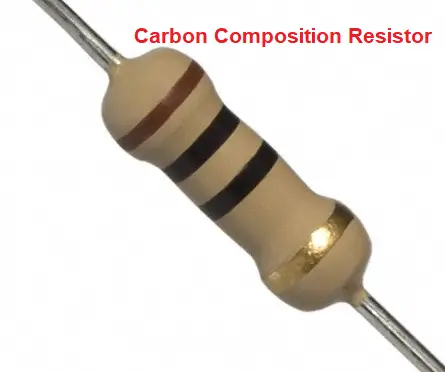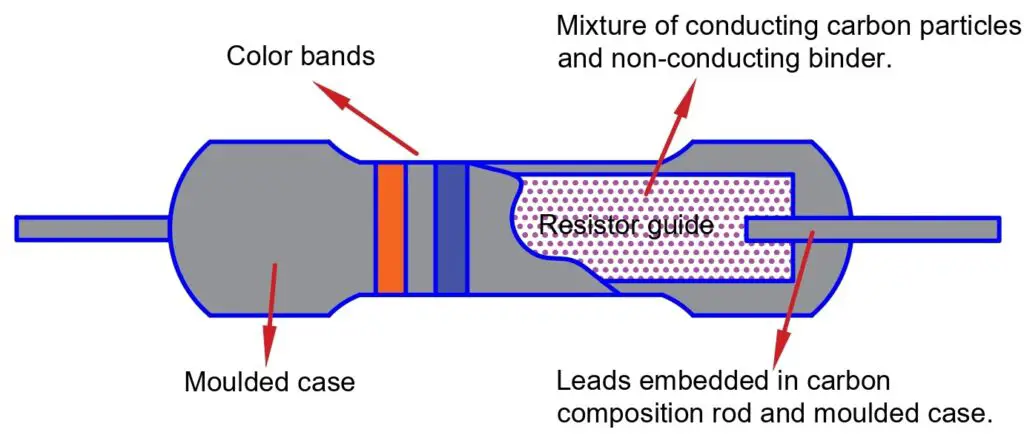Carbon composition resistors are made out of fine carbon particles mixed with clay ( a binder material). It becomes solid form after baking. Carbon composition resistors are widely used in electrical and electronic circuits.
In this article, we will discuss carbon composition resistors, their construction, factors affecting the resistance, types of noise generated by it, advantages, disadvantages, and applications.
What is a Carbon Composition Resistors?
A fixed-value resistor with a carbon composition can be used to restrict or regulate the passage of electric current. It has a solid cylindrical resistive element with integrated wire leads or metal end caps to which the lead wires are joined. It is made of carbon powder and graphite.

Its resistance value is determined by the ratio of carbon to binder material. The more carbon in the mixture, the lower the resistance value, and vice versa.
- It is ideal for high frequency.
- Very cheap to make
- Available within 1ohm to 25 mega ohms
Construction of Carbon Composition Resistors
A carbon composition resistor is made by combining carbon granules with a non-conductive ceramic substance and molding it into a cylindrical shape. To provide electrical connections, two metal leads are affixed to the ends of the cylinder. The ceramic layer offers mechanical support and insulation, while the carbon composition material works as a resistive element.
In the following picture, there is a black portion which is a solid cylindrical rod, which is made of carbon powder and graphite. Along with it, there are metal end caps connected to the terminals.

Nowadays, the bulk of carbon composition resistors are produced by depositing a metal or carbon layer over a ceramic carrier. To protect them, the body of this resistor might be covered with paint or plastic materials. The internal overview of the carbon composition resistor is shown in the below image.

Manufacturing Process
The process of manufacturing of carbon composition resistor is given below.
- The raw material for the carbon composition resistor is a blend of graphite, ceramic dust, and resin.
- The mixture of the above-said materials is pressed under high temperature and pressure to form it into sticks.
- Two metal caps are fitted at both ends of the sticks shaped resistor.
- The assembly is then heated up, and after this process of baking a massive resistance body is created.
- Then, the coating is done on the resistor to make the resistor body non-porous.
- The resistor body is cut into the lengths for the required resistance value.
- For different power rating resistors, the diameter is varied to vary the heat dissipation.
Factors Affecting Resistance of Carbon Composition Resistors
The resistance of a carbon composition resistor’ can change under many circumstances. Some of the most important elements influencing the resistance of a .these resistors are as follows.
- Composition – The resistance value is determined by the proportion of carbon and non-conductive material used in its manufacturing. Lower resistance results from more carbon concentration, and vice versa.
- Manufacturing Tolerances – Tolerance ratings are frequently assigned to carbon composition resistors, showing the permissible range of resistance values from the prescribed nominal value.
- Temperature -The resistance of carbon composition resistors, like that of other resistors, varies with temperature. Resistance often increases with increasing temperature.
- Environmental Conditions – Humidity, moisture, and other environmental conditions can all alter the resistance.
- Mechanical Stress – Excessive mechanical stress or vibration on the resistor might cause resistance changes. This can happen if the resistor is not correctly placed or is subjected to physical strain while being handled or used.
Resistance of these types of resistors also depends upon the following factors:
- Amount of carbon added
- Length of a solid cylindrical rod
- The cross-sectional area of the solid cylindrical area
Types of Noise Generated by Carbon Composition Resistors
The carbon film resistors produce noise, which is undesired random fluctuations in voltage or current that can affect the functioning of electronic circuits. They produce the following types of noises.
- Johnson noise
- Current noise
(1). Johnson Noise:
This sort of noise, also known as Johnson-Nyquist noise or thermal noise, is present in all resistors and results from the unpredictably moving charge carriers (electrons) inside the resistor’s material. Temperature and resistor resistance are intimately correlated with thermal noise.
In comparison to other resistor types like metal film or wire wound resistors, carbon composition resistors often exhibit more thermal noise. Thermal noise is a randomly changing voltage that is produced by thermally agitated charges in the resistance track.
(2). Current Noise:
Current noise in resistors with carbon content, especially those with higher values, can cause a serious problem. If we record a DC current flowing through an electrical conductor, we would be able to observe little, erratically occurring ripples on the “surface” with sufficiently high amplification. When compared to thermal noise, they show up as an increase in mean-square voltage. The contribution is sometimes referred to as current noise or just noise.
It mostly manifests itself in materials whose resistance is created by junctions between conductive particles enmeshed in an isolator substance. It reminds one of the early carbon microphones’ coal grains. Current area and conductivity are drastically altered at the contact sites, which causes current noise. However, current noise is also produced in pure metals in wires and films, even though levels are often low.
Advantages
The benefits of carbon composition resistors make them appropriate for particular applications. The following are some advantages.
- Ability to withstand high-energy pulses
- High thermal mass
- Wide resistance range
- High voltage applications
- High power handling
- Non-inductive
- Well-established technology
- Small Size
- Low cost
Disadvantages
Because of its numerous drawbacks, these resistors are becoming less common and are only sometimes used in contemporary electronic circuits. Among the most significant drawbacks are:
- High noise
- Low precision and tolerance
- Instability and drift
- Aging
- Larger size
- Low reliability
- Availability and cost
- Sensitivity to humidity
- Lower temperature coefficient( 1200 ppm/°C).
- Poor Insulation Resistance (109 Ω ).
- Non-linear characteristics
Applications of Carbon Composition Resistors
Although carbon composition resistors have been utilized in a variety of applications in the past, their use has declined over time as more sophisticated technologies, film-type resistors, have emerged. The application of these resistors is listed below. :
- The televisions
- Radios
- Audio boosters
- Power sources
- Oscillators
- Filters
- Semiconductor circuits
- Microphones
- Instrument amplifiers
- Teleprompter systems
- Systems for industrial control
- Signal producers
- Communication technology
- Regulators of power
- Ballasts for lights
- Modulators
- Signal enhancers
- CRTs, or cathode ray oscilloscopes
- Digital meters
- High-frequency applications
- Used in X-ray, Radar, and welding technology
- Used for current limiting applications
Conclusion
A fixed-value resistor with a carbon composition can be used to restrict or regulate the passage of electric current. Graphite and carbon powder make up its composition. A cylindrical carbon composition resistor is created by mixing carbon granules with a non-conductive ceramic material. Two metal leads are fastened to the ends of the cylinder to serve as electrical connectors.
The carbon composition material serves as a resistive element, while the ceramic layer provides mechanical support and insulation. Resistors made of carbon can generate noise, which are unwanted random fluctuations in voltage or current that can harm the functionality of electronic circuits.
The following types of noise are produced by carbon composition resistors, Current, and Johnson noise. Then we studied about advantages, disadvantages, and applications of carbon composition resistors in detail.